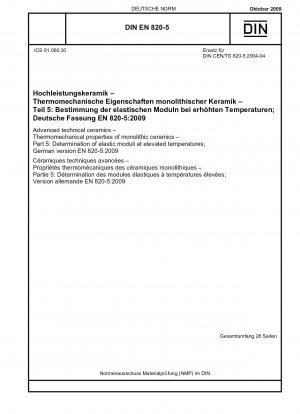DIN EN 820-5:2009
Advanced technical ceramics - Thermomechanical properties of monolithic ceramics - Part 5: Determination of elastic moduli at elevated temperatures; English version of DIN EN 820-5:2009-10
- Standard No.
- DIN EN 820-5:2009
- Release Date
- 2009
- Published By
- German Institute for Standardization
- Status
- Replace By
- DIN EN 820-5:2009-10
- Latest
- DIN EN 820-5:2009-10
- Scope
- This part of EN 820 describes methods for determining the elastic moduli, specifically Young's modulus, shear modulus and Poisson's ratio, of advanced monolithic technical ceramics at temperatures above room temperature. The standard prescribes three alternative methods for determining some or all of these three parameters: A the determination of Young's modulus by static flexure of a thin beam in three- or four-point bending. B the determination of Young's modulus by forced longitudinal resonance, or Young's modulus, shear modulus and Poisson's ratio by forced flexural and torsional resonance, of a thin beam. C the determination of Young's modulus from the fundamental natural frequency of a struck bar (impulse excitation method). This part of EN 820 extends the above-defined room-temperature methods described in EN 843-2 to elevated temperatures. All the test methods assume the use of homogeneous test pieces of linear elastic materials. The test assumes that the test piece has isotropic elastic properties. At high porosity levels all of the methods can become inappropriate. The maximum grain size (see EN 623-3), excluding deliberately added whiskers, should be less than 10 % of the minimum dimension of the test piece. NOTE 1 Method C in EN 843-2 based on ultrasonic time of flight measurement has not been incorporated into this part of EN 820 Although the method is feasible to apply, it is specialised, and outside the capabilities of most laboratories There are also severe restrictions on test piece geometries and methods of achieving pulse transmission. For these reasons this method has not been included in EN 820-5. NOTE 2 The upper temperature limit for this test depends on the properties of the test pieces, and can be limited by softening within the timescale of the test. In addition, for method A there can be limits defined by the choice of test jig construction materials. NOTE 3 Methods B and C may not be appropriate for materials with significant levels of porosity (i.e. > 15 %) which cause damping and an inability to detect resonances or natural frequencies, respectively. NOTE 4 This method does not provide for the effects of thermal expansion, i.e. the measurements are based on room temperature dimensions. Depending upon the use to which the data are put. it can be necessary to make a further correction by multiplying each dimensional factor in the relevant equations by a factor (1 + α- ΔT) where α is the mean linear expansion coefficient over the temperature interval ΔT from room temperature.
DIN EN 820-5:2009 Referenced Document
- EN 820-1 Advanced technical ceramics - Method of testing monolithic ceramics; Thermomechanical properties - Part 1: Determination of flexural strength at elevated temperatures*, 2024-04-19 Update
- EN 843-1:2006 Advanced technical ceramics - Mechanical properties of monolithic ceramics at room temperature - Part 1: Determination of flexural strength*, 2024-04-19 Update
- EN ISO 7500-1 Metallic materials - Verification of static uniaxial testing machines - Part 1: Tension/compression testing machines - Verification and calibration of the force-measuring system
- EN ISO/IEC 17025 General requirements for the competence of testing and calibration laboratories*, 2017-12-01 Update
- ISO 3611 Geometrical product specifications (GPS) — Dimensional measuring equipment — Design and metrological characteristics of micrometers for external measurements*, 2023-05-01 Update
- ISO 463 Geometrical Product Specifications (GPS) - Dimensional measuring equipment - Design and metrological characteristics of mechanical dial gauges; Technical Corrigendum 2
- ISO 6906 Vernier callipers reading to 0,02 mm
DIN EN 820-5:2009 history
- 2009 DIN EN 820-5:2009-10 Advanced technical ceramics - Thermomechanical properties of monolithic ceramics - Part 5: Determination of elastic moduli at elevated temperatures; German version EN 820-5:2009
- 2009 DIN EN 820-5:2009 Advanced technical ceramics - Thermomechanical properties of monolithic ceramics - Part 5: Determination of elastic moduli at elevated temperatures; English version of DIN EN 820-5:2009-10
